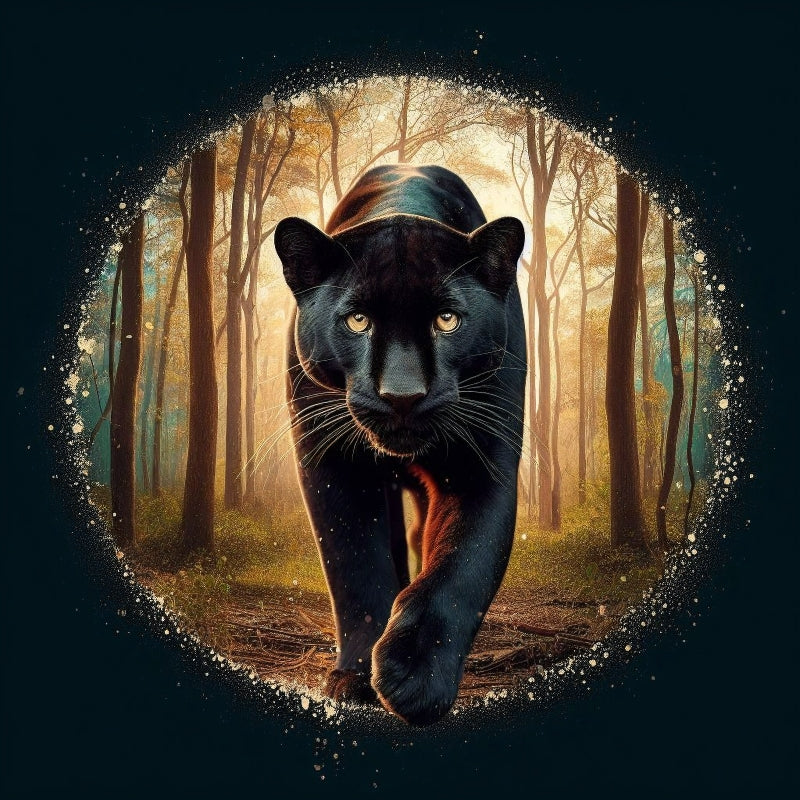
Why Black Panther is Important?
Share
The black panther, often regarded as one of nature's most enigmatic creatures, holds significant ecological, cultural, and conservation value. As a melanistic variant of the leopard (Panthera pardus) and jaguar (Panthera onca), the black panther plays a crucial role in maintaining the balance of ecosystems and serves as a symbol of wildlife conservation efforts worldwide. This blog post explores the importance of black panthers through various lenses, including their ecological roles, cultural significance, and the challenges they face in the wild.
-
Ecological Significance of Black Panther
Black panthers are apex predators, which means they sit at the top of the food chain in their respective habitats. Their presence is vital for maintaining the health and balance of ecosystems. Here are several ways in which black panthers contribute to ecological stability:
- Regulating Prey Populations: As top predators, black panthers help control populations of herbivores such as deer and wild boar. By regulating these populations, they prevent overgrazing and ensure that vegetation remains healthy. This balance is essential for promoting biodiversity within their ecosystems. Studies have shown that when apex predators like black panthers are removed from an ecosystem, it can lead to an overabundance of herbivores, resulting in habitat degradation and loss of plant diversity (Ripple et al., 2016).
- Cascading Effects on Other Species: The influence of black panthers extends beyond their direct prey. Their hunting activities can create opportunities for other species by allowing smaller predators to thrive in areas where competition is reduced. For example, when black panthers hunt larger prey, they may inadvertently provide scavenging opportunities for smaller carnivores and birds (Athreya et al., 2013).
- Biodiversity Promotion: By controlling prey populations and influencing vegetation dynamics, black panthers play a crucial role in promoting overall biodiversity within their habitats. Healthy ecosystems with diverse plant and animal life are more resilient to environmental changes and disturbances.
-
Cultural Importance of Black Panther
Black panthers have held significant cultural value across various societies throughout history. Their striking appearance and elusive nature have made them symbols of power, mystery, and beauty in folklore and mythology.
- Symbolism in Folklore: In many cultures, black panthers are revered as symbols of strength and protection. They often appear in myths and legends as guardians of the forest or as powerful spirits that embody the wilderness's untamed nature.
- Artistic Representation: The allure of black panthers has inspired countless works of art, literature, and film. Their representation in popular culture often emphasizes their grace and enigmatic qualities, further solidifying their status as iconic animals.
- Conservation Icons: In modern times, black panthers have become symbols for wildlife conservation efforts. Their plight highlights broader issues such as habitat loss, poaching, and human-wildlife conflict. Conservation organizations often use the image of the black panther to raise awareness about the need to protect not only these magnificent creatures but also their habitats.
-
Conservation Challenges of Black Panther
Despite their ecological importance and cultural significance, black panthers face numerous threats that jeopardize their survival:
- Habitat Loss: Deforestation, urbanization, and agricultural expansion have led to significant habitat destruction for black panthers. As their natural habitats shrink, these big cats are forced into smaller territories where they may struggle to find food and mates.
- Poaching: Illegal hunting poses a severe threat to black panther populations. Poachers target these animals for their beautiful pelts and body parts used in traditional medicine or as trophies. Conservation efforts must focus on combating poaching through stricter enforcement of wildlife protection laws (Nowell & Jackson, 2020).
- Human-Wildlife Conflict: As human populations expand into wildlife habitats, conflicts between humans and black panthers become more frequent. Livestock predation can lead to retaliatory killings by farmers seeking to protect their animals. Addressing these conflicts requires a multifaceted approach that considers both wildlife conservation and the livelihoods of local communities (Athreya et al., 2016).
-
Conservation Efforts of Black Panthers
Efforts to conserve black panther populations are crucial for maintaining biodiversity and ecosystem health:
- Protected Areas: Establishing protected areas such as national parks and wildlife reserves is essential for safeguarding black panther habitats. These areas provide safe havens for these big cats while allowing ecosystems to thrive without human interference.
- Community Engagement: Engaging local communities in conservation efforts is vital for long-term success. Community-based initiatives that promote coexistence between humans and wildlife can reduce conflicts while fostering positive attitudes toward conservation (Athreya et al., 2013).
- Research and Monitoring: Ongoing research is necessary to understand black panther populations better, including their behavior, habitat requirements, and interactions with humans. Long-term monitoring programs can provide valuable data that inform conservation strategies (Harihar et al., 2011).
- The Role of Education
Education plays a pivotal role in promoting awareness about the importance of black panthers:
- Raising Awareness: Educational campaigns can inform local communities about the ecological benefits of preserving black panther populations. Understanding the role these predators play in maintaining healthy ecosystems can foster support for conservation initiatives.
- Inspiring Future Generations: Engaging young people through educational programs about wildlife conservation can inspire future generations to care for their natural heritage. By instilling a sense of responsibility towards protecting wildlife like black panthers, we can cultivate a culture of conservation.
Conclusion
The importance of black panthers extends far beyond their captivating appearance; they are integral components of healthy ecosystems and symbols of cultural significance across various societies. As apex predators, they regulate prey populations, promote biodiversity, and influence ecological dynamics. However, the challenges facing black panther populations are significant, necessitating urgent action from conservationists, policymakers, and local communities alike. By prioritizing habitat protection, combating poaching, addressing human-wildlife conflict, and fostering community engagement through education initiatives, we can work towards securing a future for these magnificent creatures.
In conclusion, protecting black panthers is not just about saving a single species; it is about preserving the intricate web of life that sustains our planet's biodiversity. Through collaborative efforts aimed at conserving these iconic animals and their habitats, we can ensure that future generations will continue to marvel at the beauty and significance of black panthers in our world. This blog post provides an insightful look into why black panthers are important from multiple perspectives while emphasizing the need for ongoing conservation efforts supported by scholarly articles on wildlife conservation.
Also Read:
1. 10 Interesting Facts about Black Panthers
2. Where Black Panthers are found in India?
Citations:
[1] https://www.jetir.org/papers/JETIR2406278.pdf
[2] https://myfwc.com/wildlifehabitats/wildlife/panther/biology/
